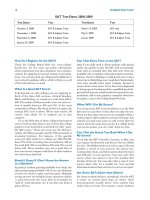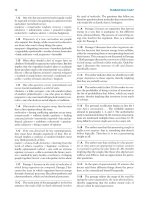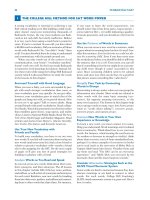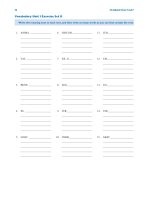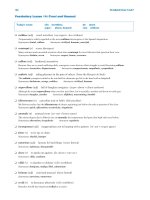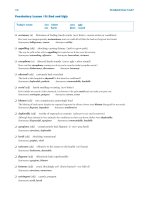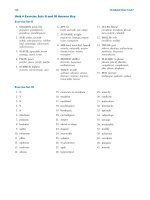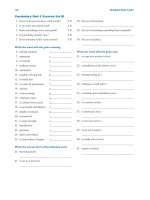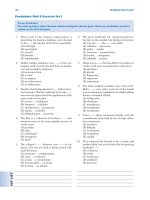Sat - MC Grawhill part 22 potx
Bạn đang xem bản rút gọn của tài liệu. Xem và tải ngay bản đầy đủ của tài liệu tại đây (164.51 KB, 10 trang )
SAT Practice 7:
Thinking Logically About the Questions
The following is an excerpt from John Adams’ A
Dissertation on the Canon and Feudal Law,
written in 1765. John Adams (1735–1826) was
the first vice-president of the United States and
the second president of the United States.
Liberty cannot be preserved without a general
knowledge among the people, who have a
Line right, from the frame of their nature, to
knowledge, as their great Creator, who does
5 nothing in vain, has given them understand-
ings, and a desire to know; but besides this,
they have a right, an indisputable, unalien-
able, indefeasible, divine right to that most
dreaded and envied kind of knowledge; I
10 mean, of the characters and conduct of their
rulers. Rulers are no more than attorneys,
agents, and trustees, for the people; and if the
cause, the interest and trust, is insidiously be-
trayed, or wantonly trifled away, the people
15 have a right to revoke the authority that they
themselves have deputed, and to constitute
abler and better agents, attorneys and trustees.
And the preservation of the means of knowl-
edge among the lowest ranks is of more im-
20 portance to the public than all the property of
all the rich men in the country. It is even of
more consequence to the rich themselves, and
to their posterity. The only question is
whether it is a public emolument;
1
and if it is,
25 the rich ought undoubtedly to contribute, in
the same proportion as to all other public bur-
dens—that is, in proportion to their wealth,
which is secured by public expenses. But none
of the means of information are more sacred, or
30 have been cherished with more tenderness and
care by the settlers of America, than the press.
Care has been taken that the art of printing
should be encouraged, and that it should be
easy and cheap and safe for any person to
35 communicate his thoughts to the public. . . .
Let us dare to read, think, speak and write.
Let every order and degree among the people
rouse their attention and animate their resolu-
tion. Let them all become attentive to the
40 grounds and principles of government, eccle-
siastical
2
and civil. Let us study the law of
nature; search into the spirit of the British
Constitution; read the histories of ancient
ages; contemplate the great examples of
200 MCGRAW-HILL’S SAT
45 Greece and Rome; set before us the conduct
of our own British ancestors, who have
defended for us the inherent rights of mankind
against foreign and domestic tyrants and
usurpers, against arbitrary kings and cruel
50 priests; in short, against the gates of earth and
hell. Let us read and recollect and impress
upon our souls the views and ends of our own
more immediate forefathers in exchanging
their native country for a dreary, inhospitable
55 wilderness. Let us examine the nature of that
power, and the cruelty of that oppression,
which drove them from their homes. Recollect
their amazing fortitude, their bitter suffer-
ings—the hunger, the nakedness, the cold,
60 which they patiently endured—the severe
labors of clearing their grounds, building their
houses, raising their provisions, amidst dan-
gers from wild beasts and savage men, before
they had time or money or materials for com-
65 merce. Recollect the civil and religious princi-
ples and hopes and expectations which
constantly supported and carried them
through all hardships with patience and resig-
nation. Let us recollect it was liberty, the hope
70 of liberty for themselves and us and ours,
which conquered all the discouragements,
dangers and trials. In such researches as these
let us all in our several departments cheerfully
engage—but especially the proper patrons and
75 supporters of law, learning and religion!
1
Benefit
2
Related to church matters
CHAPTER 4 / CRITICAL READING SKILLS 201
6. Which of the following best describes the relation-
ship between the first paragraph (lines 1–35) and
the second paragraph (lines 36–75)?
(A) The first describes a current state of affairs,
while the second describes a situation in the
past.
(B) The first describes a right, while the second
gives recommendations for exercising that
right.
(C) The first describes a problem, while the sec-
ond describes a way to remedy that problem.
(D) The first describes a theory, while the second
describes the evidence for that theory.
(E) The first addresses the leaders of a country,
while the second addresses its citizens.
7. According to the passage, citizens should
I. understand the precepts by which gov-
ernments and churches are run
II. take up arms for their country in the
name of liberty
III. appreciate the sacrifices of their
forefathers
IV. study to partake in their government as
elected officials
(A) I and III only
(B) I, II, and III only
(C) I, II, and IV only
(D) I, III, and IV only
(E) II, III, and IV only
1. The “right” in line 7 is the right of the people to
(A) pursue happiness
(B) read what they wish
(C) know about their leaders
(D) set up printing presses
(E) run for public office
2. In context, the word “constitute” (line 16) most
nearly means
(A) consist of
(B) produce
(C) remove
(D) install
(E) enjoy
3. It can be inferred from the passage that “our
own more immediate forefathers” (lines 52–53)
endured all of the following EXCEPT
(A) political oppression
(B) difficult terrain
(C) arduous labor
(D) hopelessness
(E) physical deprivation
4. As it is described in line 56, the “power” is
(A) a personal skill
(B) a national virtue
(C) a despotic agent
(D) a mysterious spirit
(E) a fearsome mirage
5. The tone of the second paragraph (lines 36–75) is
best described as
(A) prescriptive
(B) critical
(C) objective
(D) melancholy
(E) joyous
202 MCGRAW-HILL’S SAT
4. Best choice: B Focus on the exclusivity of the
answers:
(A) Voters always choose incapable political
candidates. (“Always” is exclusive; statement
is mean.)
(B) Voters should be more educated about can-
didates. (Reasonable and inclusive.)
(C) Political candidates rarely campaign effec-
tively. (“Rarely” is somewhat exclusive; state-
ment is harsh.)
(D) Politicans do not represent their constituents
well. (“Do not” is exclusive; statement is
mean.)
(E) Voters are not interested in critical political
issues. (Since this answer would imply that
(B) is also true, it must be wrong.)
5. Best choice: D or E Think about what can rea-
sonably be accomplished in 400–800 words.
(A) to dissuade students from studying political
science (Reasonable but harsh and petty.)
(B) to describe the evolution of ethics in Ameri-
can history (Far too big a task.)
(C) to attack the credibility of politicians
(Reasonable but harsh.)
(D) to refute a misconception (Reasonable.)
(E) to prescribe a solution to a problem
(Reasonable.)
Concept Review 7
1. The answer must be “positive” because it includes
“extremely enthusiastic.” In other words, anyone
who is “extremely enthusiastic” is necessarily
also “positive.” Therefore, “extremely enthusiastic”
cannot be correct without “positive” also being
correct, but this contradicts the fact that there is
only one correct answer.
2. Because writers generally write about things that
interest them. And even when they write about
things that don’t interest them (as when they are
given an assignment), they still at least pretend to
be interested, so they do not write with a tone of
indifference.
3. Best choice: E What would a reasonable person
say about where art primarily comes from? You
don’t need special knowledge here, just common
sense.
(A) desire for wealth (Are most artists money-
grubbers? Probably not.)
(B) anxiety (Are most artists anxious? Could be,
but that’s mean.)
(C) exact imitation (Do most artists make exact
copies? No.)
(D) reason (Do most artists paint logically? Prob-
ably not.)
(E) intuition (Do most artists rely on feelings and
hunches? Seems reasonable.)
Answer Key 7:
Thinking Logically About the Questions
SAT Practice 7
1. C The “right” is described as the right to “knowl-
edge . . . of the characters and conduct of their
rulers.”
2. D The sentence says that “the people have a
right to revoke the authority that they themselves
have deputed, and to constitute abler and better
agents. . . .” This means that they can remove the
leaders who don’t lead well and replace them with
those who do. So constitute means something like
replace them with, or choice (D) install.
3. D The passage explains that “our own more
immediate forefathers” experienced
(A) political oppression: “that oppression . . .
which drove them from their homes” (lines
56–57)
(B) difficult terrain: “inhospitable wilderness”
(lines 54–55)
(C) arduous labor: “severe labors” (lines 60–61)
(E) physical deprivation: “the hunger, the naked-
ness, the cold” (line 59)
CHAPTER 4 / CRITICAL READING SKILLS 203
6. B The first paragraph describes the “right . . . to
knowledge,” while the second describes what kind
of knowledge the citizens should acquire.
7. A The passage does not advocate taking up arms
or running for office. It does, however, say that cit-
izens should “become attentive to the grounds and
principles of government, ecclesiastical (church-
related), and civil” (lines 39–41) and reflect on
their forefathers’ “amazing fortitude [and] bitter
sufferings” (lines 58–59).
However, lines 69–71 say that it was “the hope
of liberty . . . which conquered all the
discouragements. . . .”
4. C The “power” is described as that “which drove
them from their homes.” So it is a despotic agent.
5. A Most sentences begin with “Let us . . . ,” which
indicates that he is strongly suggesting what his
fellow citizens should do. He is prescribing action.
204 MCGRAW-HILL’S SAT
Lesson 8:
Checking That You’ve Nailed the Answer
Avoid the Choices That Are True but
Wrong
Too often students make the mistake of choosing an
answer that makes a true statement but does not an-
swer the question correctly. How can that be? Imagine
that you’ve read a passage written by an art critic
praising a museum that has been harshly criticized by
others. The passage acknowledges certain flaws in the
planning and design of the building but on the whole
praises the building for its innovations. Then you read
a question like this:
The author uses the term “monstrosity” (line 4) pri-
marily in order to
(A) justify the building of the museum
(B) characterize the opinion of certain critics
(C) express his dismay about certain decisions made
by the planners
(D) disparage the work of certain architects
(E) praise the museum for its innovative design
Looking back to line 4, you read: “They could not
understand how such a monstrosity could have been
erected under their noses.” When you look at the pas-
sage as a whole, you see that the author does, in dif-
ferent places, “justify the building of the museum”
(choice (A)), “characterize the opinion of certain crit-
ics” (choice (B)),“express his dismay about certain de-
cisions made by the planners” (choice (C)), and
“praise the museum for its innovative design” (choice
(E)). These are all basically “true” statements. So how
do you pick the right answer? Read the question care-
fully. It asks why the author uses the term “monstros-
ity.” Does the author think the museum is a
monstrosity? No, because the passage as a whole
praises the museum. The sentence in line 4 says that
they—other critics—thought it was a monstrosity.
Therefore, this word is being used to (B) characterize
the opinion of certain critics.
Some choices may make statements that are
true without being the correct answer to the
question. Read the question very carefully to be
sure you’ve answered what it asks. Carefully
note the question type, as discussed in Lesson 5.
Underline Your Evidence
It’s worth repeating: To check your answers,
underline your evidence in the passage. This
forces you to focus on what is in the passage
and not what is just in your head. The right an-
swers are always right there in the passage, if
you look for them. You never need to draw on
outside knowledge or read between the lines.
Keep Your Eyes on the Prize
Always check your progress in terms of your score
goal. Unless you’ve got a realistic shot at an 800, you
don’t need to get every question right. Don’t get
bogged down on tough questions. If you can’t decide
between two answers, make your best guess and
move on. Keep in mind that to break 500, you need
only to get about half of the questions right, and to
break 600, you need to get only about two-thirds of
the questions right. To break 700, though, you’ll need
to get more than 86% of the questions right.
In addition to checking individual answers,
check that you’ve carefully attacked at least the
number of questions that you should accord-
ing to your “SAT Study Plan.”
Learn to Deal with “Space-Outs”
Nearly everyone “spaces out” from time to time when
they read. Have you ever suddenly realized that
you’ve “read” three paragraphs but nothing has sunk
in? This is costly only if you panic and let it distract
you for the rest of the test.
If you space out a little on the SAT reading,
relax. It happens to everyone, and you’ll be fine
if you don’t panic. Just calmly go back to
where you left off, and reread normally. To
minimize space-outs, just focus on answering
the three key questions and summarizing each
paragraph. When your brain has a conscious
task, it doesn’t space out.
CHAPTER 4 / CRITICAL READING SKILLS 205
Concept Review 8:
Checking That You’ve Nailed the Answer
1. What does it mean for an answer to be “true” but “wrong”?
2. How do you avoid choices that are “true” but “wrong”?
3. Why is it helpful to underline evidence for your answers in the passage?
4. What is your score goal on the SAT CR section, and what percentage of the questions should you attack in
order to get that score?
5. How should you deal with “space-outs” on the CR section?
206 MCGRAW-HILL’S SAT
SAT Practice 8:
Checking That You’ve Nailed the Answer
our minds. Neanderthals, stronger than us, did
not need to take this route. They could
50 survive with their physical strength rather than
tapping into the potential of their brains. An
analogy is with countries: the richest ones,
such as Switzerland, Finland, Singapore, and
Japan, are not blessed with, but rather lack
55 natural resources. Without them, they have
been forced to use their brains to innovate,
providing products and services ranging from
mobile phones to diplomacy.
1. The main purpose of the second paragraph (lines
17–43) is to
(A) make a suggestion
(B) examine some claims
(C) explain a situation
(D) present information objectively
(E) tell a story
2. In line 20, the phrase “win out” most nearly
means
(A) become justified
(B) defeat their foes by force
(C) come to dominate
(D) become politically successful
(E) become more popular
3. The evidence in lines 34–36 (“Anthropologists find
. . . speech”) is presented primarily in order to
(A) refute the misconception that hunter-
gatherers were not good communicators
(B) explain how modern humans replaced the
Neanderthals
(C) support the claim that hunter-gatherers have
larger brains than Neanderthals
(D) suggest that long vocal chambers may not
provide an advantage to a particular species
(E) show why some humans prefer gestures to
spoken language
The following passage is taken from a book
written in 2002 about the evolution of human
intelligence.
We are a bright species. We have gone into
space and walked on the moon. Yet you would
Line never have guessed that if you traveled back to
between 100,000 and 40,000 years ago. At that
5 time our ancestors and Neanderthals coex-
isted. Neanderthals were like us but physically
stronger, with large bones and teeth, protrud-
ing brows and face, and hardly a chin. Perhaps
what we lacked in brawn we made up for
10 in brains. But for most of our history, our
species was not bright enough to act very dif-
ferently from the Neanderthals, let alone be
more successful than they were. Only around
40,000 to 32,000 years ago, in Western Asia
15 and Europe, did Neanderthal people disap-
pear, to be replaced by our species.
Why did we coexist with Neanderthals for
60,000 years—a far longer case of hominids
living side by side than any other in human
20 history? And why did we eventually win out?
Brains alone cannot provide the answer, as Ne-
anderthals may in fact have had the larger
ones. Perhaps they lacked the long vocal cham-
ber needed for speech. Equal certainty
25 exists among those who study the base of their
skulls that they did and that they did not. If
they did lack one, then this could be the expla-
nation, but maybe not, since even without a
voice box, gestures can communicate, as can
30 be seen among the deaf. Indeed, hunters find
advantages in using sign language (speech
sounds would warn off potential prey), and not
just while hunting but in everyday life.
Anthropologists find that hunter-gatherers use
35 sophisticated sign languages to complement
their speech. Sign language might even have
other advantages—evidence even suggests that
it is easier to learn than speech: deaf children
start to pick up signs earlier than hearing
40 ones learn to speak. So “spoken speech” is not
in all ways superior to “signed speech.” It is
not something that can explain our replace-
ment of the Neanderthals.
The reason we—anatomically modern
45 humans—won out lies, we suspect, not in being
brighter or better able to speak but in our very
physical frailty and our resulting need to exploit
John R. Skoyles and Dorion Sagan, Up from Dragons. © 2002
McGraw-Hill. Reprinted by permission of The McGraw-Hill
Companies.
CHAPTER 4 / CRITICAL READING SKILLS 207
5. In line 58, “mobile phones” and “diplomacy” are
mentioned as examples of
(A) innovations that are used worldwide
(B) different ways of communicating
(C) luxuries that are denied to the physically frail
(D) inventions that Neanderthals could never use
(E) products or services that require intellectual
rather than natural resources
4. The “physical frailty” in line 47 is
(A) the reason our ancestors struggled to survive
(B) the result of a harsh physical environment
(C) an ironic advantage to modern humans
(D) something the Neanderthals exploited
(E) a trait that arose late in human history
Answer Key 8:
Checking That You’ve Nailed the Answer
208 MCGRAW-HILL’S SAT
Concept Review 8
1. An answer is “true” but “wrong” if it reflects a
point that is made in the passage but does not an-
swer the question that is asked. Such answers are
very common on SAT Critical Reading questions.
2. You can avoid the trap of choosing a “true” but
“wrong” answer by reading the question very care-
fully and focusing on the specific line references it
mentions and on the question it asks.
3. Underlining the evidence in the passage helps you
to focus on what is in the passage rather than
what is in your head.
4. The percentage of questions that should be
attacked to get particular score goals are as follows:
500 = 75%, 550 = 80%, 600 = 85%, 650 = 90%, 700
and above = 100%.
5. First, don’t panic. When you notice that you have
spaced out, calmly come back to the point where
you left off and continue to read. The key to avoid-
ing “space-outs” in the first place is to focus on an-
swering the three key questions and summarizing
each paragraph.
1. B Words and phrases such as “perhaps” (line 23),
“if” (line 26), and “maybe not” (line 28) indicate
that the second paragraph is examining
hypotheses.
2. C The passage explores the question of how
modern humans came to “win out” (line 20) over
the Neanderthals, that is, how they came to thrive
while the Neanderthals died out, or how they
came to dominate them.
3. D The sentence “Anthropologists find . . .
speech” (lines 34–36) is used to support the later
claim that “‘spoken speech’ is not in all ways supe-
rior to ‘signed speech’” (lines 40–41), which would
cast doubt on the advantages of the “long vocal
chamber needed for speech” (lines 23–24).
4. C According to the final paragraph, the relative
“physical frailty” (line 47) of modern humans
compared to Neanderthals created a need for
modern humans to “tapping . . . into the potential
of their brains” (line 51), which led to their domi-
nance over the Neanderthals.
5. E The “mobile phones” and “diplomacy” in line
58 are examples of how countries that “lack nat-
ural resources” (lines 54–55) can still “use their
brains to innovate” (line 56).
SAT Practice 8
CHAPTER 5
✓
209
SENTENCE COMPLETION
SKILLS
1. Verbal Inference
2. The Four Logical Relationships
3. Structural Keys
4. Simplifying the Sentence
5. Using Context Intelligently
6. The Toughest Sentences
Copyright © 2008 by The McGraw-Hill Companies, Inc. Click here for terms of use.
